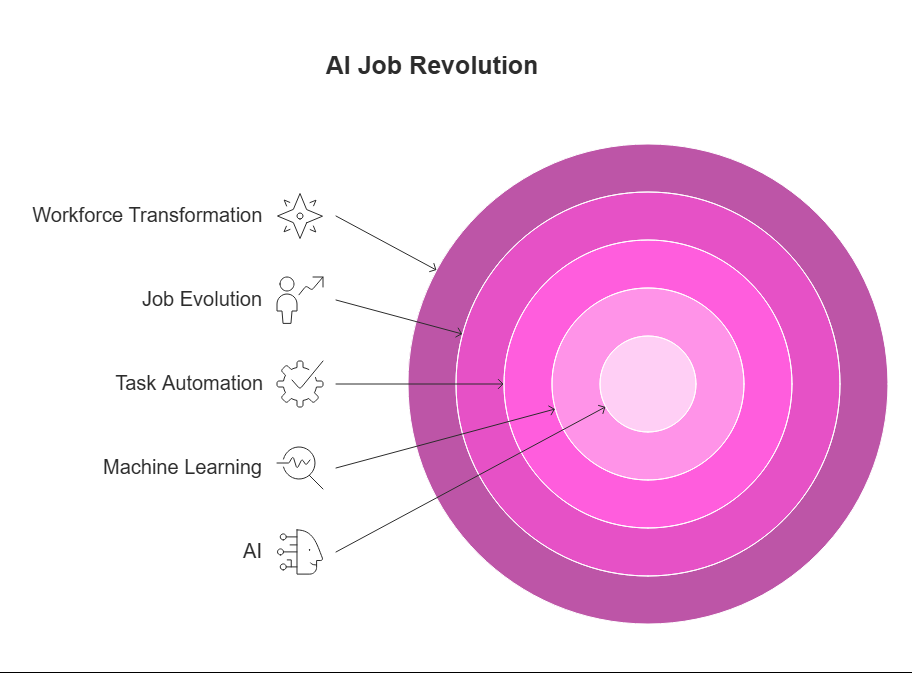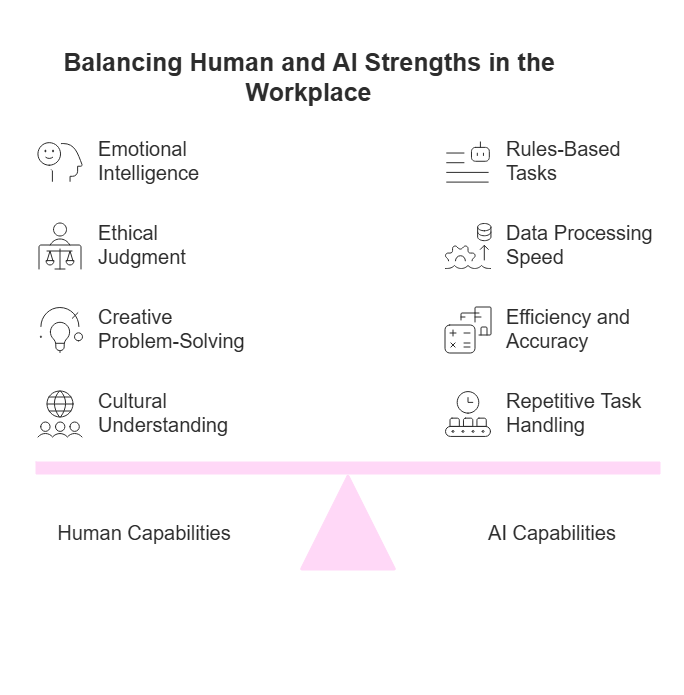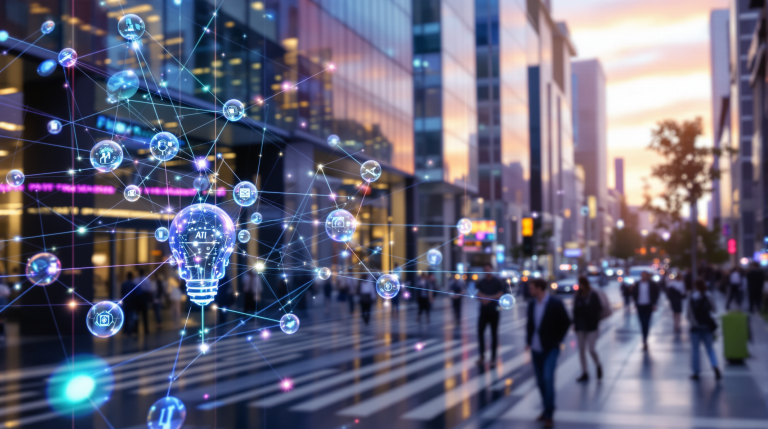AI reshapes our work landscape at unprecedented speed. This article explores how these changes affect careers across industries and what steps professionals can take to adapt. Recent data suggests AI could transform up to 300 million jobs worldwide by 2030, with some roles facing elimination while others evolve or emerge.
You’ll discover why this AI wave differs from previous technological shifts and how the distinction between task automation and complete job replacement matters. The article provides research-backed insights from organizations like McKinsey, Oxford University, and the Bureau of Labor Statistics to help you navigate this changing landscape.
Whether you work in finance, healthcare, creative fields, or skilled trades, understanding these trends helps position you for success as AI continues transforming how we work.
AI and the Future of Work: What's Really Happening to Jobs?
By 2030, AI systems could automate 30% of work hours across global industries. This striking shift raises urgent questions for professionals everywhere: Which jobs face replacement? Which will transform? Which remain secure?
AI technology advances at breakneck speed, reshaping workplace dynamics daily. Many misunderstand what’s happening, though. AI typically automates specific tasks rather than eliminating entire professions. Understanding the difference between AI and machine learning helps clarify this distinction, with research showing 23% projected growth in AI/ML roles through 2030.
Jobs fall into three categories regarding AI impact: those facing replacement (routine, data-heavy roles), those experiencing enhancement (where AI augments human capabilities), and those remaining relatively untouched (requiring uniquely human traits). For knowledge workers navigating these changes, developing certain skills becomes essential.
Throughout this guide, we’ll explore each category in depth, providing practical strategies to thrive amid technological transformation. The future belongs to professionals who view AI as a collaborative partner rather than a threat.
The AI Job Revolution Understanding the Impact
In our modern workplace, AI advances faster than any tech wave before it. Previous innovations changed physical labor. AI transforms knowledge work instead. Jobs across finance, healthcare, and marketing face rapid evolution. According to recent data, AI could reshape up to 300 million jobs worldwide by 2030.
Most AI systems don’t replace entire jobs. They automate specific tasks within roles. Financial analysts might spend less time gathering data. This gives them more capacity for strategic thinking. To grasp this distinction, we need to understand the difference between AI and machine learning. AI broadly mimics human thinking. ML represents its data-driven subset. These specialized roles show 23% projected growth through 2030.
Current statistics reveal a complex job landscape. Software developer positions may grow 17.9% by 2033. Personal financial advisor roles could increase 17.1%, as shown in U.S. Bureau of Labor Statistics projections. Yet simultaneously, about 47% of U.S. workers might see their roles threatened by AI within a decade. Approximately 14% may need to change careers entirely, according to recent research.
Generative AI marks the latest evolutionary leap in this field. These systems move beyond simple automation. They tackle creative tasks once considered uniquely human. Our teams now witness AI systems that can:
- Generate marketing copy that converts
- Design website layouts from text descriptions
- Create code based on natural language requests
- Produce realistic images from written prompts
This ability to process both structured and unstructured data changes what machines can accomplish. In a way, we’re seeing a fundamental shift in workplace capabilities.

The Three Ways AI Impacts Jobs
First, routine tasks face replacement through automation. Data entry, basic customer service, and standardized document processing become machine work. Jobs heavily dependent on these functions will likely transform or diminish.
Second, human capabilities get enhanced rather than eliminated. Our doctors use AI to spot patterns in medical images. Lawyers employ it for contract analysis. Marketers leverage it for customer insights. This collaboration often produces better results than either humans or machines working alone.
Third, entirely new career paths emerge from AI development. Machine learning engineers, prompt engineers, and AI ethics specialists represent roles that didn’t exist a decade ago. These positions combine technical knowledge with human judgment. So, we’re seeing job creation alongside transformation.
Why This Time Feels Different for AI
Previous AI waves promised much but delivered incrementally. Today’s generative models represent a quantum leap forward. They understand context and generate human-quality content. They learn from minimal examples. This creative capability extends beyond structured tasks into domains requiring imagination.
Development cycles have accelerated dramatically. Models once taking years to train now emerge in months. Capabilities double at unprecedented rates. Organizations must adapt continuously rather than making occasional adjustments. Actually, this rapid iteration creates both challenges and opportunities for our workforce.
Industry adoption has shifted from experimental to essential. Banking, healthcare, and creative fields now integrate AI into core operations. Recent analysis shows 83% of companies consider AI a strategic priority. Implementation spans across departments rather than staying isolated in tech teams. This widespread integration suggests we’ve crossed a threshold. AI has become fundamental to competitive advantage rather than just an option.
Jobs AI Will Likely Replace by 2030
AI advances will transform many careers by 2030. Research from McKinsey shows nearly 30% of work hours could be automated globally within five years. Jobs with predictable, repetitive tasks face the highest risk. These positions typically follow clear rules and need minimal creative judgment. Productivity might actually increase by 1.4% annually as these changes unfold.
Several factors speed up this workplace shift:
- Cheaper AI implementation costs
- Machine accuracy exceeding human performance
- Expanded data availability for training
- Corporate pressure to cut expenses
- Ongoing workforce shortages
Major companies already demonstrate this transition in action. JPMorgan uses COIN software that handles document review previously requiring 360,000 lawyer hours yearly. Amazon’s warehouse robots cut picking time in half. UPS employs AI routing that saves millions while delivering packages faster than human planners could arrange.
According to Exploding Topics research, around 300 million jobs worldwide might face displacement soon. Advanced economies could see up to 60% of positions affected somewhat. Let’s explore four job categories particularly vulnerable to automation by decade’s end.
Data Entry and Processing Roles
Data entry positions face extremely high automation risk. These roles involve transferring information between systems and maintaining databases. Banking operations have basically automated 38% of data processing tasks already, as industry analysis shows.
Financial companies now process loans without human review. Logistics firms automatically extract shipping details from emails. Insurance companies use systems that read claims forms independently. In a way, these changes highlight how rule-based tasks quickly shift to machine control.
Customer Service and Support Positions
Traditional support roles undergo rapid transformation through AI assistants. Modern chatbots now handle complex customer interactions with surprising skill. These systems resolve common issues, process returns, answer product questions, and schedule appointments automatically.
Benefits extend beyond just cost savings for businesses. AI support works 24/7 without breaks. It handles multiple customers at once while maintaining quality. Wait times during busy periods virtually disappear. Companies like American Express report 35% higher customer satisfaction after implementing these tools for routine inquiries.
Basic Content Creation and Curation
Content production faces significant disruption from generative AI tools. Systems now create news summaries, product descriptions, and basic marketing copy quite effectively. LEO optimization techniques show how AI generates blog drafts optimized for search engines in minutes rather than hours.
Creative nuance remains challenging for machines, obviously. Media organizations use AI for sports recaps and earnings reports. E-commerce sites generate thousands of product descriptions daily through automation. Marketing teams schedule email campaigns and social posts using these generative tools.
Routine Analysis and Reporting Jobs
Business analysts who mainly produce standard reports face substantial pressure from automation. Modern AI dashboards automatically spot trends and create visualizations without manual work. They generate written explanations of findings and distribute insights on schedule.
The era of manually updating spreadsheets and creating presentation decks is fading fast. Financial analysts who once spent days on quarterly reports now see that work completed in minutes. Market research roles increasingly shift toward strategic advisory positions as machines handle the basic analysis work.
Jobs AI Will Enhance But Not Replace
Many professions actually gain significant advantages when AI enters the picture. Instead of disappearing, these roles transform. In fact, professionals using AI consistently achieve better results than those working without it. McKinsey’s research shows that, well, 92% of companies plan to boost AI investments. Their focus? Enhancement rather than workforce reduction.
So what happens when knowledge workers team up with AI assistants? Pretty amazing things:
- Minutes replace hours for task completion
- Complex processes see fewer errors
- Creative possibilities grow beyond individual limits
- Better data analysis improves decisions
AI technologies speed up tasks, reduce errors, and spark creativity for knowledge workers. They learn user preferences too, offering increasingly personalized assistance. These systems excel at recognizing patterns in large datasets, though complex models still need human oversight.
Recent employment data supports this enhancement view. The Bureau of Labor Statistics projects nearly 18% growth for software developers through 2033. Personal financial advisors will likely see 17.1% growth in the same period. Both fields heavily use AI yet continue expanding. This trend appears across numerous sectors where AI serves more as partner than replacement.

How AI Transforms Knowledge Work
Knowledge workers experience perhaps the most dramatic workplace transformation. Retrieval-Augmented Generation merges AI outputs with real-time data for greater accuracy.
Lawyers now review contracts in minutes instead of hours. They maintain higher accuracy rates too. The technology grounds AI responses in vetted sources, reducing inaccuracies.
Medical professionals, in some respects, benefit similarly. They analyze patient data against the latest research almost instantly. Financial analysts use AI dashboards that continuously monitor markets. These tools flag opportunities human eyes might miss.
In each case, the professional remains essential. Their expertise, judgment, and ethical considerations simply cannot be automated.
Creative Fields as AI Collaborators
Creative professionals find AI particularly valuable as idea partners. Designers sketch rough concepts that AI transforms into multiple variations. This process accelerates ideation significantly.
Writers sometimes overcome creative blocks through AI-suggested directions. Musicians experiment with computer-generated melodies that spark new ideas. The pattern stays consistent: AI handles mechanical aspects while humans direct creative vision.
Marketing teams might generate dozens of headline options through AI. They then apply human judgment to select those aligning with brand values. This collaboration produces results neither could achieve alone. The human provides direction, emotional intelligence, and cultural context. AI contributes speed, variation, and pattern recognition.
Technical Roles with Mundane Tasks Automated
Technical professionals probably benefit most dramatically from AI assistance. Software engineers now generate routine code automatically. This frees them to focus on architecture and innovation instead.
Quality assurance specialists automate repetitive tests. They can then concentrate on edge cases and user experience. DevOps teams use AI to monitor systems and predict potential failures before they happen.
According to research on ethical AI implementation, 79% of leaders view AI as vital for staying competitive. About 90% of knowledge workers report saving significant time with these technologies.
Jobs AI Cannot Replace Yet
What makes us uniquely human in this digital age? Despite AI’s rapid advancement, certain professions remain firmly in human hands. This reality stems from our irreplaceable qualities that machines simply cannot duplicate.
Harvard Business Review research confirms that AI excels at rules-based tasks but lacks human empathy and judgment. These qualities actually form the foundation of numerous essential fields where human touch matters most.
The World Economic Forum identifies significant job growth through 2027 in roles requiring distinctly human capabilities. Agricultural equipment operators and vocational education teachers represent just a few positions demanding adaptability and contextual understanding that AI systems cannot yet match.
4 key limitations keep certain jobs in our hands:
- Emotional intelligence and empathy
- Ethical judgment in ambiguous situations
- Creative problem-solving in unpredictable environments
- Cultural and contextual understanding
The Bureau of Labor Statistics projects continued demand for roles requiring these human elements. Legal professionals and financial advisors maintain strong growth despite AI adoption. In fact, these professionals demonstrate that human-AI synergy creates optimal outcomes, neither replacing the other but working together.

Healthcare and Caregiving Professions
Empathy defines healthcare roles. Patients consistently report that compassionate care significantly impacts their recovery outcomes.
While AI tools analyze medical images and suggest treatment protocols, the reassuring presence of a human caregiver cannot be digitized. Nurses provide comforting bedside manner. Physicians communicate difficult diagnoses with sensitivity.
Therapists build trust through genuine connection, work that goes beyond algorithmic capabilities. This explains why we see continued growth in nursing and mental health professions despite technological advances.
Leadership and Strategic Decision-Making
Effective leaders navigate ambiguity with skill. They balance competing priorities and make ethical judgments, capabilities that remain uniquely human.
In our experience, strategic leadership involves understanding subtle team dynamics. Leaders integrate diverse perspectives and consider unquantifiable factors beyond pure efficiency.
When faced with unprecedented situations lacking historical data, we draw on experience and intuition. These qualities explain why C-suite roles remain human-centered, with AI serving more or less as decision support rather than decision-maker.
Skilled Trades and Physical Work
Skilled trades show remarkable resilience against automation. Electricians troubleshoot complex systems with practiced hands. Plumbers adapt to unique structural challenges on the spot.
Carpenters make real-time adjustments to materials, performing work requiring physical dexterity combined with problem-solving. These professionals handle constantly changing environments.
A construction site presents unique challenges daily, weather variations, material inconsistencies, and unexpected structural issues. This explains why the World Economic Forum projects continued demand for skilled trades in the coming years.
Jobs Requiring Complex Human Interaction
Nuanced human interaction remains our domain. Negotiators read subtle emotional cues that machines miss. Mediators navigate complex interpersonal dynamics with finesse.
Sales professionals build authentic relationships through shared experiences. These roles require understanding unspoken social contexts and cultural nuances.
Effective negotiation involves sensing when to press forward and when to compromise. While AI may analyze communication patterns, it cannot authentically connect with emotions. This limitation explains why these professions continue to thrive in an increasingly automated world.
Skills That Remain Valuable in an AI-Driven Economy
Developing the right skills can increase our salaries by up to 40% in today’s AI-driven marketplace. Research from Oxford University reveals that professionals with machine learning expertise earn significantly more than their peers. In fact, those combining AI knowledge with human-centric capabilities command the highest premiums.
These findings highlight a crucial truth: the most valuable professionals blend technical AI understanding with distinctly human attributes. While technical expertise matters, certain fundamental human skills remain irreplaceable across industries.
McKinsey’s global survey confirms this trend, showing one-third of organizations now use generative AI regularly. Yet, many struggle to find talent with the right mix of technical and human capabilities. This gap creates opportunities for those who develop skills AI won’t replace.
So, what makes these future-proof skills so valuable? They represent capabilities that AI systems fundamentally struggle to replicate:
- Contextual understanding across diverse situations
- Moral reasoning based on shared human values
- Genuine emotional connection and empathy
- Creative thinking that transcends existing patterns
Organizations recognize this reality, with 79% viewing AI as critical for competitiveness. At the same time, they’re investing in continuous learning and adaptability programs. The most successful companies don’t just deploy AI, they actually develop human capabilities that complement it.
Emotional Intelligence and Empathy
In some respects, emotional intelligence remains uniquely human. This ability to recognize, understand, and manage emotions enables professionals to build authentic connections with colleagues and clients in ways algorithms simply cannot replicate.
Sales professionals who read subtle emotional cues close deals more effectively. Healthcare providers demonstrating genuine empathy achieve better patient outcomes. Leaders understanding team dynamics create psychological safety that drives innovation.
These emotional capabilities, too, transcend industry boundaries, creating value wherever human relationships matter. The capacity to build trust through authentic connection represents perhaps the most automation-resistant skill in today’s economy.
Creative Problem-Solving and Innovation
Honestly, genuine creativity stands as a distinctly human trait. While AI excels at optimization within known parameters, humans uniquely identify entirely new approaches to problems.
Designers reimagining product categories, scientists formulating breakthrough hypotheses, and entrepreneurs envisioning new business models all demonstrate thinking beyond algorithmic boundaries. This creativity thrives especially in ambiguous situations where clear rules don’t exist.
Organizations increasingly value professionals who, in a way, combine creative thinking with AI tools. This partnership creates solutions neither humans nor machines could develop independently.
Ethical Judgment and Decision-Making
Complex ethical dilemmas require moral reasoning that remains beyond AI capabilities. Professionals making nuanced ethical judgments that consider multiple stakeholders provide irreplaceable value.
Healthcare administrators must balance resource allocation decisions. Financial advisors consider client well-being beyond profit. Technology leaders ensure responsible AI deployment. All these roles exercise ethical judgment machines cannot replicate.
As AI systems grow more powerful, the ability to ensure their ethical use becomes increasingly valuable. This capability extends to ensuring AI transparency and accountability, skills that, obviously, grow more critical as algorithms influence significant decisions.
Adaptability and Continuous Learning
Well, perhaps most valuable is our capacity to continuously evolve alongside technological change. AI tools adapt to user preferences and require periodic retraining, demanding that professionals continuously update their approaches.
Professionals viewing learning as ongoing rather than completed demonstrate remarkable career resilience. They experiment with new AI capabilities and identify emerging opportunities before they become mainstream requirements.
This adaptability extends beyond technical knowledge to include flexibility in working methods and problem-solving strategies. As AI capabilities evolve rapidly, the ability to learn, unlearn, and relearn becomes the ultimate future-proof skill that AI won’t replace.
How to Future-Proof Your Career in the Age of AI
AI transformation reshapes our professional landscape daily. Recent surveys reveal 22% of U.S. workers worry about AI replacing their jobs. This number has steadily increased since 2021, as highlighted in Forbes research. Anxiety alone won’t secure our futures, though. Action will.
Organizations actually expect significant returns from AI integration. About 64% of companies anticipate major efficiency improvements from these technologies, according to a comprehensive guide on AI tool development. This creates opportunities for professionals who position themselves at the intersection of human expertise and technological advancement.
Three strategies stand out for those of us looking to thrive alongside AI:
- Master AI-human collaboration workflows
- Develop distinctly human capabilities
- Gain hands-on experience with AI tools
Leeds Insights research confirms this approach with interesting data. While 30% of current work activities might face automation by 2030, AI will likely create more jobs than it eliminates. This is especially true for professionals who embrace continuous learning and develop complementary skills.
Becoming an AI-Human Collaboration Expert
Professionals who thrive won’t merely use AI tools. We’ll master the art of human-AI collaboration. This means grasping AI’s capabilities, limits, and workflows. Resources on the difference between AI and machine learning provide essential context for our learning journey.
Beyond technical understanding, we need workflows that leverage AI strengths while applying human judgment. For instance, AI can handle initial research or draft generation. We then apply our expertise to evaluate and refine the output. In a way, this positions us as conductors rather than competitors of AI systems.
Championing ethical AI use within our organizations raises our value. By questioning bias, transparency, and appropriate application, we become thoughtful leaders in AI integration. This role becomes increasingly important as adoption spreads throughout industries.
Developing Your Uniquely Human Advantages
Technical skills matter, but our most automation-resistant assets are distinctly human capabilities. Emotional intelligence tops this list, understanding others’ feelings and perspectives. Unlike technical skills that might become obsolete, emotional intelligence grows more valuable as automation increases.
We can strengthen this capability through deliberate practice:
- Seek feedback on how others perceive our interactions
- Listen actively without planning responses
- Engage with diverse perspectives to expand empathic range
- Reflect on emotional dynamics in challenging situations
Ethical judgment represents another irreplaceable human strength. We develop this through case studies and discussions about complex dilemmas. The ability to navigate ambiguous situations becomes increasingly valuable as routine decisions shift to algorithms. Actually, this judgment capability often separates successful professionals from those who struggle with AI integration.
Learning to Build and Work With AI Tools
Hands-on experience with AI tools provides both practical skills and deeper understanding. Even non-technical professionals benefit from basic tool-building knowledge. The process need not overwhelm us.
A step-by-step guide to building AI tools outlines seven phases from purpose definition to deployment. No-code platforms make this accessible to those without programming backgrounds. These platforms allow us to prototype solutions for specific domain challenges.
Starting small with focused projects yields big insights:
- Identify repetitive tasks in our work that consume significant time
- Define what success looks like if these tasks were automated
- Explore no-code AI platforms addressing similar challenges
- Build simple prototypes, even if imperfect
- Test, refine, and document learnings
This experience provides technical knowledge and demonstrates initiative to employers. It also builds confidence in our ability to adapt as AI capabilities evolve. Too often, professionals avoid this hands-on approach out of fear. Yet failed experiments yield valuable insights that enhance our understanding of AI’s practical applications and limitations.
FAQs
How can I leverage AI to enhance my current role?
To enhance current roles, consider upskilling with AI tools. Optimizing job searches using AI-powered tools can prove beneficial. Networking can improve through AI-driven platforms.
Which careers remain safe from AI automation?
Careers requiring empathy and complex human interaction are safer from AI. Teaching and nursing are unlikely to be replaced by machines. Service jobs, such as hair stylists and diplomats, should remain human-centric.
What human skills will stay in demand in an AI-driven future?
Human skills like communication and creativity will stay in demand. Emotional intelligence is a skill that will remain valuable. These skills cannot be replaced by AI and are crucial for success.



